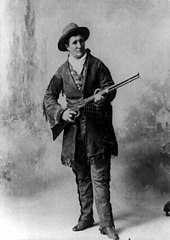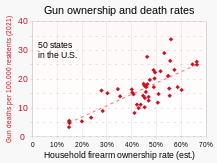Gun culture in the United States encompasses the behaviors, attitudes, and beliefs about firearms and their use by private citizens. Gun ownership in the United States is legally protected by the Second Amendment to the United States Constitution. Firearms are used for self-defense, hunting, and recreation.
Gun politics in the United States tends to be polarized between advocates of gun rights, often conservative or libertarian, and those who support stricter gun control, often liberal. The gun culture of the United States is unique among developed countries in the large number of firearms owned by civilians, generally permissive regulations, and high levels of gun violence compared to other developed countries.
History

American militia culture
American attitudes on gun ownership date back to the American Revolutionary War, and also arise from traditions of hunting, militias, and frontier living.
Justifying the unique attitude toward gun ownership in the United States, James Madison wrote in Federalist No. 46, in 1788:
Those who are best acquainted with the last successful resistance of this country against the British arms, will be most inclined to deny the possibility of it. Besides the advantage of being armed, which the Americans possess over the people of almost every other nation, the existence of subordinate governments, to which the people are attached, and by which the militia officers are appointed, forms a barrier against the enterprises of ambition, more insurmountable than any which a simple government of any form can admit of. Notwithstanding the military establishments in the several kingdoms of Europe, which are carried as far as the public resources will bear, the governments are afraid to trust the people with arms. And it is not certain, that with this aid alone they would not be able to shake off their yokes. But were the people to possess the additional advantages of local governments chosen by themselves, who could collect the national will and direct the national force, and of officers appointed out of the militia, by these governments, and attached both to them and to the militia, it may be affirmed with the greatest assurance, that the throne of every tyranny in Europe would be speedily overturned in spite of the legions which surround it.

The American hunting and sporting passion comes from a time when the United States was an agrarian, subsistence nation where hunting was a profession for some, an auxiliary source of food for some settlers, and also a deterrence to animal predators. A connection between shooting skills and survival among rural American men was in many cases a necessity and a rite of passage for manhood. Hunting endures as a central sentimental component of a gun culture to control animal populations across the country, regardless of modern trends away from subsistence hunting and rural living.
The militia spirit derives from an early American dependence on arms to protect themselves from foreign armies and hostile Native Americans. Survival depended upon everyone being capable of using a weapon. Before the American Revolution there was neither budget nor manpower nor government desire to maintain a full-time army. Therefore, the armed citizen-soldier carried the responsibility. Service in militia, including providing one's own ammunition and weapons, was mandatory for all men. Yet, as early as the 1790s, the mandatory universal militia duty gave way to voluntary militia units and a reliance on a regular army. Throughout the 19th century, the institution of the civilian militia began to decline.
Closely related to the militia tradition was the frontier tradition with the need for a means of self-protection closely associated with the nineteenth-century westward expansion and the American frontier. In popular literature, frontier adventure was most famously told by James Fenimore Cooper, who is credited by Petri Liukkonen with creating the archetype of an 18th-century frontiersman through such novels as The Last of the Mohicans (1826) and The Deerslayer (1840).
The American Scots-Irish settlers arguably best epitomized this frontier spirit. Emigrating from Britain in what had historically been an economically poor and incredibly violent region, these immigrants brought with them an intense pride, individualism and love of guns which would shape future decedent's views and help form the origin of American gun culture. Settling in Appalachia, the Scots-Irish would lead the push westward and eventually populate a band stretching from Appalachia to Texas and Oklahoma, and particularly after the Dust Bowl into Southern California.
African American gun culture
A distinct and growing sub-culture of American gun culture has been developed and promoted by African Americans since at least the end of the American Civil War. From Frederick Douglass, DuBois, Ida B. Wells and Marcus Garvey, the American Civil Rights movement, and the Pan-African movement, an array of African American gun cultures and philosophies of violence and self-defense have proliferated in American life.
Ownership levels
"Americans made up 4 percent of the world's population but owned about 46 percent of the entire global stock of 857 million civilian firearms." U.S. civilians own 393 million guns. American civilians own more guns "than those held by civilians in the other top 25 countries combined."
In 2018 it was estimated that U.S. civilians own 393 million firearms, and that 40% to 42% of the households in the country have at least one gun. However, record gun sales followed in the following years. The U.S. has by far the highest estimated number of guns per capita in the world, at 120.5 guns for every 100 people.
Although historically there have been significant differences in respect to gun ownership between different races and sexes, that gap may be closing. For example, women and ethnic minorities saw the sharpest rise of private gun ownership in the United States in 2020 and the ongoing ownership trends do not indicate any sign of abatement. Also, in 2020 and 2021 a sharp increase in gun ownership was seen due to the riots and pandemic during that time.[22][23] Nearly half of the gun buyers appeared to be first-time owners.[23] Over 2 million firearms were purchased during the pandemic alone.
According to Gallup, in 2020, 32% of U.S. adults said they personally own a gun, while a larger percentage, 44%, report living in a gun household.
Popular culture


In the late 19th century, cowboy and "Wild West" imagery entered the collective imagination. The first American female superstar, Annie Oakley, was a sharpshooter who toured the country starting in 1885, performing in Buffalo Bill's Wild West show. The cowboy archetype of the individualist hero was established largely by Owen Wister in stories and novels, most notably The Virginian (1902), following close on the heels of Theodore Roosevelt's The Winning of the West (1889–1895), a history of the early frontier. Cowboys were also popularized in turn of the 20th century cinema, notably through such early classics as The Great Train Robbery (1903) and A California Hold Up (1906)—the most commercially successful film of the pre-nickelodeon era.
Gangster films started in 1910, but became popular only with the advent of sound in film in the 1930s. The genre was boosted by the events of the prohibition era, such as bootlegging and the St. Valentine's Day Massacre of 1929, the existence of real-life gangsters such as Al Capone and the rise of contemporary organized crime and escalation of urban violence. These movies flaunted the archetypal exploits of "swaggering, cruel, wily, tough, and law-defying bootleggers and urban gangsters".[29]
Since World War II, Hollywood produced many morale-boosting movies, patriotic rallying cries that affirmed a sense of national purpose. The image of the lone cowboy was replaced in these combat films by stories emphasizing group efforts and the value of individual sacrifices for a larger cause, often featuring a group of men from diverse ethnic backgrounds who were thrown together, tested on the battlefield, and molded into a dedicated fighting unit.
Guns frequently accompanied famous heroes and villains in late 20th-century American films, from the outlaws of Bonnie and Clyde (1967) and The Godfather (1972), to the fictitious law and order avengers like Dirty Harry (1971) and RoboCop (1987). In the 1970s, films portrayed fictitious and exaggerated characters, madmen ostensibly produced by the Vietnam War in films like Taxi Driver (1976) and Apocalypse Now (1979), while other films told stories of fictitious veterans who were supposedly victims of the war and in need of rehabilitation (Coming Home and The Deer Hunter, both 1978). Many action films continue to celebrate the gun toting hero in fantastical settings. At the same time, the negative role of the gun in fictionalized modern urban violence has been explored in films like Boyz n the Hood (1991) and Menace 2 Society (1993).
Political and cultural theories


Gun culture and its effects have been at the center of major debates in the US's public sphere for decades. In his 1970 article "America as a Gun Culture," historian Richard Hofstadter used the phrase "gun culture" to characterize America as having a long-held affection for guns, embracing and celebrating the association of guns and an overall heritage relating to guns. He also noted that the US "is the only industrial nation in which the possession of rifles, shotguns, and handguns is lawfully prevalent among large numbers of its population". In 1995, political scientist Robert Spitzer said that the modern American gun culture is founded on three factors: the proliferation of firearms since the earliest days of the nation, the connection between personal ownership of weapons and the country's revolutionary and frontier history, and the cultural mythology regarding the gun in the frontier and in modern life. In 2008, the US Supreme Court affirmed that the right of individuals to possess firearms is guaranteed by the Second Amendment.
Terms applied to opponents
Terms used by gun rights and gun control advocates to refer to opponents are part of the larger topic of gun politics.
The term gun nut refers to firearms enthusiasts who are deeply involved with the gun culture. It is regarded as a pejorative stereotype cast upon gun owners by gun control advocates as a means of implying that they are fanatical, exhibit abnormal behavior, or are a threat to the safety of others. Some gun owners embrace the term affectionately.
The term hoplophobia refers to an "irrational aversion to firearms", and US Marine Jeff Cooper claims to have invented the term in the 1960s.






